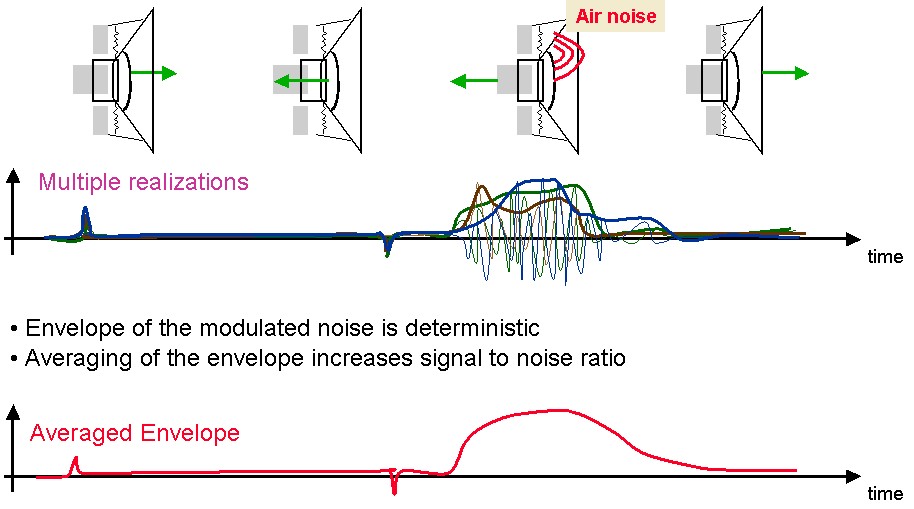Air Leakage Noise
Characteristics: | KLIPPEL R&D System | KLIPPEL QC System |
|---|---|---|
Absolute envelope of modulated noise MOD | ALD | |
Relative envelope of modulated noise RMOD | ALD | |
Peak value of random distortion RAND | TRF | |
Peak value of deterministic distortion DET | TRF | |
Crest factor of deterministic distortion CREST | TRF | |
Mechanical loss factor Qms | ||
Port resonance frequency fp | IMP, MSC |
The air passing a leakage at the dust cap or in the enclosure generates turbulent noise which is audible and which is perceived as a loudspeaker defect. Conventional spectral analysis shows broad-band noise which is very similar to the measurement noise generated by the microphone or production noise. Averaging will not increase the sensitivity of the measurement because air leakage noise is as random as the disturbances. However, time domain analysis reveals a deterministic envelope of the air leakage noise which is modulated by the sound pressure. Using a sinusoidal excitation signal of known frequency, the envelope can be calculated. Increasing the measurement time corresponds with an averaging of the deterministic envelope and will increase the sensitivity of the measurement beyond the human ear. The demodulation technique combined with a microphone array allows to detect the position of the noise source.
KLIPPEL R&D SYSTEM (development)
Module | Comment |
|---|---|
TRF PRO may only be used for detecting the air noise by exploiting the intensity of the higher-order harmonics. A separation between Rub & Buzz and air leakage noise is not possible. |
KLIPPEL QC SYSTEM (end-of-line testing)
Module | Comment |
|---|---|
Sound Pressure Task (SPL) |
The normal SPL measurement task is the simplest way for detecting significant air leakage noise. Particular symptoms of air leakage are not detected and cannot be used for diagnostics. |
The leakage detection task uses only one microphone for detecting the air noise by the sensitive demodulation technique. Here, only the intensity of the modulation can be used to detect the position of the source approximately. The 2nd microphone may be located in the far field for detecting production noise. | |
MSC measures the mechanical quality factors of the drive unit Qms and of the vented box system. | |
IMP measures the mechanical quality factor Qms which indicates a leaky dust cap. |
Templates of KLIPPEL products
Name of the Template | Application |
|---|---|
TRF rub+buzz w/o Golden Unit | Rub & Buzz detection without "Golden Unit" according Application Note AN 22 |
TRF rub+buzz with Golden Unit | Rub & Buzz detection with "Golden Unit" according Application Note AN 23 |
Diagnost. RUB&BUZZ Sp1 | Batch of Rub & Buzz tests with increased voltage (applied to high power devices) |
Diagnost. RUB & BUZZ Sp2 | Batch of Rub & Buzz tests with increased voltage (applied to low power devices) |
TRF Crest Harmonics (x,f) | Crest factor harmonic distortion versus displacement to find Rub & Buzz and other loudspeaker defects |
TRF Peak harmonics, time domain | Peak value of higher-order harmonics in time domain for Rub & Buzz analysis |
Diagnost. MIDRANGE Sp1 | Comprehensive testing of midrange drivers with a resonance 30 Hz < fs < 200 Hz using standard current sensor 1 |
Diagnost. SUBWOOFER (Sp1) | Comprehensive testing of subwoofers with a resonance 10 Hz < fs < 70 Hz using standard current sensor 1 |
Diagnostics MICROSPEAKER Sp2 | Comprehensive testing of microspeakers with a resonance 100 Hz < fs < 2 kHz using sensitive current sensor 2 |
Diagnostics TWEETER (Sp2) | Comprehensive testing of tweeters with a resonance 100 Hz < fs < 2 kHz using sensitive current sensor 2 |
Diagnostics VENTED BOX SP1 | Comprehensive testing of vented box systems using standard current sensor 1 |
Diagnostics WOOFER (Sp1) | Comprehensive testing of subwoofers with a resonance 30 Hz < fs < 200 Hz using standard current sensor 1 |
LPM Microspeaker T/S (SP2) | Linear parameters of microspeakers using sensitive current sensor 2 |
LPM Subwoofer T/S (Sp1) | Linear parameters of subwoofers using standard current sensor 1 |
LPM Subwoofer T/S (Sp2) | Linear parameters of subwoofers using sensitive current sensor 2 |
LPM Tweeter T/S (SP2) | Linear parameters of tweeters using sensitive current sensor 2 |
LPM Woofer T/S (Sp1) | Linear parameters of woofers using standard current sensor 1 |
LPM Woofer T/S (Sp2) | Linear parameters of woofers using sensitive current sensor 2 |
LSI Woofer+Box Nonl. P Sp1 | Nonlinear parameters of woofers operated in free air, sealed or vented enclosure with a resonance frequency fs < 300 Hz at standard current sensor Sp1 |
Diagnostics WOOFER Sp1,2 | Comprehensive testing of subwoofers with a resonance 30 Hz < fs < 200 Hz using current sensor 1 and 2 |
Application Notes
Standards
Audio Engineering Society
AES2 Recommended practice Specification of Loudspeaker Components Used in Professional Audio and Sound Reinforcement
International Electrotechnical Commission
IEC 60268-5 Sound System Equipment, Part 5: Loudspeakers
Other Related Tests
DC displacement – dynamic offset the voice coil
Harmonic distortion
Compression of fundamental components
Separated loudspeaker distortion
Multi-tone distortion
Intermodulation distortion
Auralization
Transducer nonlinearities (curve shape)
Rub & Buzz and impulsive distortion
Transducer nonlinearities (curve shape)
Single-valued nonlinear parameters
Typical Test Objects
Papers and Preprints
W. Klippel, Tutorial “Loudspeaker Nonlinearities - Causes, Parameters, Symptoms,” J. of Audio Eng. Soc. 54, No. 10, pp. 907-939 (2006 Oct.).
W. Klippel, U. Seidel, “Measurement of Impulsive Distortion, Rub and Buzz and other Disturbances,” presented at the 114th Convention of the Audio Eng. Soc., 2003 March 22–25, Amsterdam, The Netherlands, Preprint 5734.

